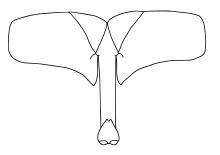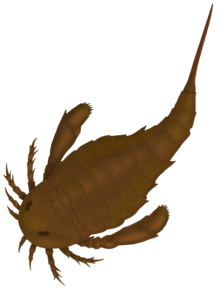Holmipterus
Holmipterus is a genus of eurypterid, an extinct group of aquatic arthropods. Fossils of Holmipterus have been discovered in deposits of the Sheinwoodian age in Europe. It only contains one species, which is in turn the type species, H. suecicus, from Gotland, Sweden.[1] The generic name honors Gerhard Holm, a Swedish paleontologist whose work in the arthropods remains as a model to follow.[2]
| Holmipterus | |
|---|---|
 | |
| Restoration of the pretelson and telson of H. suecicus, showing the cercal blades | |
| Scientific classification | |
| Kingdom: | |
| Phylum: | |
| Subphylum: | |
| Order: | |
| Superfamily: | |
| Family: | |
| Genus: | †Holmipterus Kjellesvig-Waering, 1979 |
| Type species | |
| †Holmipterus suecicus Kjellesvig-Waering, 1979 | |
It is a eurypterine of large size with unknown affinities since it shares characteristics with the megalograptids and the carcinosomatids.[2]
Description

Holmipterus was a large eurypterid, with some paratypes indicating a size of even 1.5 m (4.9 ft). It had characteristics that allow it to differentiate itself from all the eurypterids. The chelicerae (frontal appendages) had four joints, with a long, narrow and falcate (with a curvature similar to that of the sickle) chelae (claws) of 12.4 mm (0.49 in) long. The hand was about as broad as long, with a socket for the articulation of the condyle (round prominence at the end of a bone) of the 4th joint. It is 11.5 mm (0.45 in) long and 11.9 mm (0.47 in) wide. The walking legs are only known by two joints which have large, curved spines, one on each side. These walking legs are characteristic of most carcinosomatids in which the legs were flattened and with the venter (abdomen) turned anteriorly. They were different from the highly differentiated legs of Megalograptus. The spines of the walking legs were striated with narrow and longitudinal ridges along the back of the curved part. The swimming legs are known for a paddle retaining the sixth and seventh segments. The triangular lobe of the sixth joint was very long with linear scales along most of the posterior border which grade into serrated scales at the distal end. The seventh joint was large and finely serrated along the anterior edge and increasingly thick along the distal end. The eighth joint was a small triangular spine. An epimera (the part of a segment next to an articulation of an appendage) of the first tergite whose edge slopes back proves that the entire mesosoma was very tumid, as in the carcinosomatids. The most surprising morphological feature of Holmipterus is the pretelson-telson assemblage which includes the cercal blades, as in other megalograptids. It can be stated that the pretelson, and therefore probably the entire cauda (tail), was almost round in cross section, as in Megalograptidae, Carcinosomatidae and Mixopteridae, who had a rounded tail capable of being pushed "overhead", as in current scorpions. Its extraordinary telson is unique among the Eurypterida order. It was robust, curved downwards and with a serrated and flat platform in the anterior part near the bulbous articulation of the telson. The serrated edge of the telsonic platform is laterally rounded and superimposed on the underlying axis of the telson. The teeth along the serrated edge are truncated at the apical ends, so that each tooth appears to be quadrangular.[2]
See also
References
- Tetlie, O. Erik (2007). "Distribution and dispersal history of Eurypterida (Chelicerata)" (PDF). Palaeogeography, Palaeoclimatology, Palaeoecology. 252 (3–4): 557–574. doi:10.1016/j.palaeo.2007.05.011. Archived from the original (PDF) on 2011-07-18.
- Sven Laufeld; Roland Skoglund (1979). Lower Wenlock faunal and floral dynamics – Vattenfallet section, Gotland (PDF). Sveriges Geologiska Undersökning. ISBN 9171581707.
